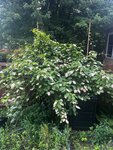

You probably know that many different fruits are commonly grown in Minnesota, like apples, raspberries, and grapes. But did you know we can also grow kiwis? Read on to learn about some unusual fruits that can add fun and flavor to your landscape.
First, as I mentioned above – yes, you can grow kiwis in Minnesota! These are not the traditional large fuzzy fruits that you often see in the grocery store, but a related cold-hardy version sometimes referred to as “kiwiberries.” They grow on vines and produce grape-sized berries with a distinctive kiwi flavor. Their skin is thin and smooth, and they do not need to be peeled before eating.
In order to produce kiwiberry fruit, you need to plant a male and a female vine (or one male vine for each 6 to 8 female vines, if you want to grow multiple plants). There are two species of sweet kiwi that can be grown in our climate - Actinidia kolomikta and Actinidia arguta. A. kolomikta is more compact and has beautiful green, white, and pink variegated foliage. The most common variety of A. kolomikta is called Arctic Beauty. A. arguta is slightly less cold-hardy and may be sold under the names Bower Berry, Issai, or simply Arguta.
You may think of apricots and peaches as strictly southern fruits, but there are varieties we can grow in our northern climate! Cold hardy apricot varieties include Westcot, Scout, and Moongold, and cold hardy peaches include Reliance, Contender, and Intrepid. The challenge with growing stone fruits in Minnesota is that they bloom early in the spring and the blooms are delicate, so if we have a late frost, the tree may not produce any fruit that year. However, if you’re comfortable with the idea that some years may be a bust, it can be really fun to grow these trees at home. In the years that you do get fruit, you will probably get a lot of it, and there’s nothing like eating a warm peach straight from the tree. These trees are fairly easy to care for – the biggest thing to watch out for is birds eating the fruit before it ripens, which can be prevented by placing netting over the trees in June through August. Also, keep in mind that you will generally need to plant at least two trees that are compatible with each other in order to produce fruit. A reputable nursery or garden center will be able to help you choose varieties that work well together.
Currants, gooseberries, and jostaberries are great fruit bushes that produce delicious berries without taking up as much space as a fruit tree. Currants grow on bushes that are generally 3-6 feet wide and tall, and produce clusters of small pea-sized berries that may be pink, white, red, or purple/black, depending on the variety. Many varieties are self-fertile, meaning that one plant will produce fruit even if there are no other currant bushes nearby. Gooseberries are similar, but produce larger grape-sized fruit that may be light green, pink, or red when ripe. Gooseberry bushes have thorns, so be careful when pruning and harvesting! Powdery mildew and pine blister rust can be a challenge for currants and gooseberries, so look for resistant varieties such as Rovada (red currant), Honeyqueen (red currant), Blanka (white currant), Titania (black currant), Poorman (gooseberry), and Invicta (gooseberry).
Jostaberries (pronounced YUST-a-berry) are a cross between a black currant and gooseberry. This is one of my personal favorite fruits for the home garden! Jostaberries are sweet, mostly thornless, disease resistant, and easy to grow. Jostaberries are self-fertile, so you only need to plant one bush, and they are shade tolerant, making them very versatile additions to the landscape. The berries are grape-sized and turn nearly black when ripe.
As you can see, if you’d like to branch out this year and try growing some interesting fruits, you have many great options! For more information, check out the University of Minnesota Extension Yard and Garden website. Extension resources are written by experts and contain the latest and most reliable research-based information. Happy gardening!
Comments
No comments on this item Please log in to comment by clicking here